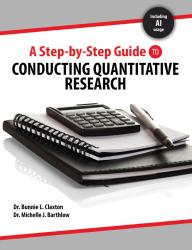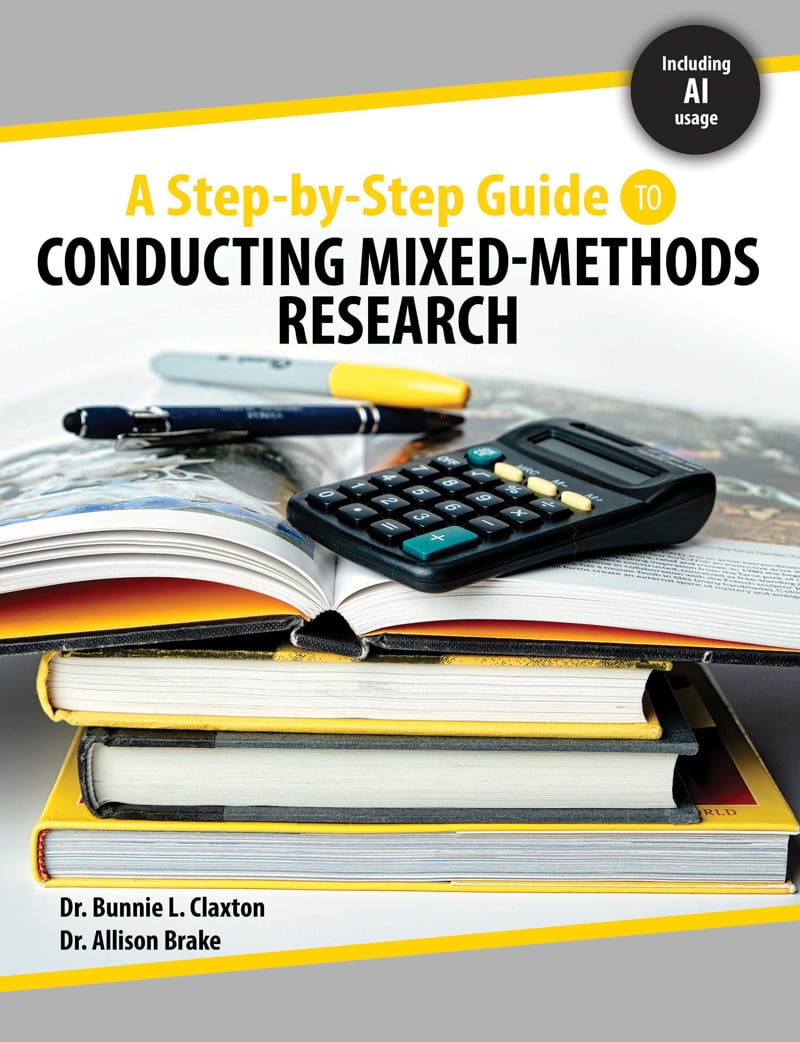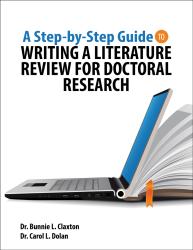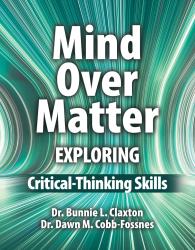Shop

Textbooks by Dr. Bunnie Claxton
A Step-by-Step Introduction to Research Methods: Qualitative, Quantitative, Mixed-Methods, and Applied was written to introduce candidates to four common research methods as they seek to determine which method is best suited for the needs of their research. This book is intended to be the foundational textbook for a research program. After learning the basic data collection and analysis techniques for each research method, candidates will select one of the four methods to conduct their own research study utilizing a step-by-step process. No other system provides this degree of guidance for the research process.
A Step-by-Step Guide to Conducting Qualitative Research was written to guide the novice researcher through the qualitative research process. The qualitative researcher will study the day-to-day lived experiences of participants and will seek to discover and narratively describe the participants’ perspective in a final research manuscript using a phenomenology, case study, narrative, ethnography, or grounded theory research design.
This Qualitative Dissertation Handbook was written for institutions who adopt “A Step-By-Step Guide to Conducting Qualitative Research”. This handbook was written to provide guidance to faculty and students to successfully navigate the qualitative dissertation process. This handbook is customizable to meet the needs of your doctoral program. Highlights include the mission of qualitative research, academic policies, dissertation guidelines, steps to complete the dissertation, and the qualitative dissertation template.
Step-by-Step Guide to Conducting Quantitative Research was written to guide candidates through the research process as they strive to adhere to a systematic approach to investigating phenomena by collecting quantifiable numerical data and analyzing it using statistical methods, which include descriptive and inferential statistics. This step-by-step approach to quantitative research is what makes this book unique.
This Quantitative Dissertation Handbook was written for institutions who adopt “A Step-By-Step Guide to Conducting Quantitative Research”. This handbook was written to provide guidance to faculty and students to successfully traverse the quantitative dissertation process. This handbook is customizable to meet the needs of your doctoral program. Highlights include the mission of quantitative research, academic policies, dissertation guidelines, steps to complete the dissertation, and the qualitative dissertation template.
A Step-by-Step Guide to Conducting Mixed-Methods Research was written to guide the novice researcher through the process of conducting mixed-methods research. Three mixed-methods designs are described using a step-by-step process and include convergent, explanatory sequential, and exploratory sequential. Details are provided to transition a dissertation into a format that can be submitted for potential publication in the scholarly literature.
This Mixed Methods Dissertation Handbook was written for institutions who adopt “A Step-By-Step Guide to Conducting Mixed Methods Research”. This handbook was written to provide guidance to faculty and students to successfully traverse the mixed methods dissertation process. This handbook is customizable to meet the needs of your doctoral program. Highlights include the mission of mixed methods research, academic policies, dissertation guidelines, steps to complete the dissertation, and the mixed methods dissertation template.
A Step-by-Step Guide to Conducting Applied Research was written to guide candidates through the doctoral process as they strive to solve a specific problem or improve a practice at a specific location such as a business or school. Applied research incorporates a multi-method design that includes both qualitative and quantitative data collection and analysis strategies. The opportunity to solve a problem or improve a practice at a specific site is what makes this book unique.
This Applied Research Dissertation Handbook was written for institutions who adopt “A Step-By-Step Guide to Conducting Applied Research”. This handbook was written to provide guidance to faculty and students to successfully traverse the applied research dissertation process. This handbook is customizable to meet the needs of your doctoral program. Highlights include the mission of applied research, academic policies, dissertation guidelines, steps to complete the dissertation, and the applied dissertation template.
A Step-by-Step Guide to Writing a Literature Review for Doctoral Research was written to teach students how to write and present a review of the current scholarly literature. Candidates learn to explain their research through a theoretical framework and to write a synthesis of the current scholarly literature. The result is a thorough review of the current scholarly literature regarding their research topic.
A Step-by-Step Guide to Conducting Communication Research was written to guide the novice researcher through the process of conducting communication research. The result is a communication research dissertation that contains the details of a specific topic in communication and implications based on the data collection and analysis results. This step-by-step approach to doctoral research is what makes this book unique.
A Step-by-Step Guide to Writing an IEP was written to clearly explain the IEP process and to complete an IEP. Topics include lawful requirements, present level of academic achievement and functional performance, measurable annual goals, accommodations, modifications, assessments, services, least restrictive environment, transition plans, a functional behavior assessment, and a behavior intervention plan. The reader is guided, step-by-step, through writing an IEP.
Planning, Writing, and Implementing IEPs: A Christian Approach was written to challenge administrators, service providers, and parents to consider an IEP from a Christian perspective. The book reminds readers that IEP meetings need not be a time of conflict and controversy, and that writing the components of an IEP can become part of a plan for the student’s future (Jeremiah 29:11).
Mind Over Matter: Critical Thinking Skills was written to teach students the skills they need to collect data, analyze data, search for facts, and think for themselves. Students are bombarded with information, much of which is inaccurate, misleading, and even hurtful. This curriculum is designed to teach students to think critically and make wise decisions based on evidence. It includes social emotional learning and critical thinking skills. This is the first version in the series and is intended for students in grades 7 to 10.
Mind Over Matter: Exploring Critical Thinking Skills is curriculum written to teach students the skills they need to collect data, analyze data, search for facts, and think for themselves. Students are bombarded with information, much of which is inaccurate, misleading, and even hurtful. This curriculum is designed to teach students to think critically and make wise decisions based on evidence.
Game Changer: Christ-Centered Critical Thinking Skills was written to teach students the skills they need to approach their thought processes from a biblical and Christ-centered perspective. Students will learn to collect data, analyze data, search for the truth, and think for themselves with the Bible as their guide. This is the first version in the series and is intended for students in grades 7 to 10.
Game Changer: Exploring Christ-Centered Critical Thinking Skills is curriculum written to teach students the skills they need to approach their thought processes from a biblical and Christ-centered approach. Students will learn to collect data, analyze data, search for the truth, and think for themselves with the Bible as their guide. Students are bombarded with information, much of which is inaccurate, misleading, and even hurtful. This curriculum is designed to teach students to think critically and make wise decisions based on evidence.
Testimonials
What People Are Saying
Doctoral Candidate
This textbook, by far, has one of the best layouts I’ve seen in my studies so far. It was easy to follow and was a joy to read. I never begrudged reading assignments in this class because of this textbook! Information was matter-of-fact, and I could facilely locate information within each chapter by the colorfully organized headings and subheadings. I am NOT selling this textbook back. I’ll definitely be keeping this one!












